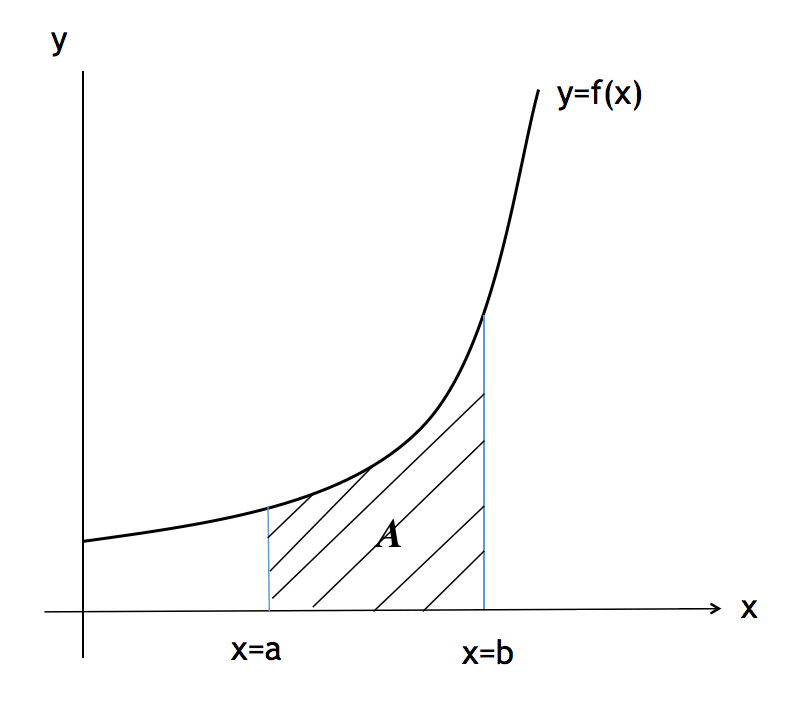Areas under curves
Consider the area A of the figure bounded by the curve y = f(x) , the x – axis and the y vertical lines through x = a and x = b and (where b > a)

If x = b then \(\scriptsize A_b = \int\limits_{x=b} y dx \)(the value of the integral and hence the area up to b )
and if x = a then\(\scriptsize A_a = \int\limits_{x=a} y dx \) (the value of the integral and hence the area up to a ).
Since b > a, the difference in these two areas \(\scriptsize ( A_b – A_a) \) gives the required area A.
A = \(\scriptsize \int\limits_{x=b} y dx\; – \; \int\limits_{x=a} y dx \)
, this is called definite integral of f(x) with respect to x, between the limits a (the lower limit) and b (the upper limit). It is a function of a and b.
The arbitraryAn arbitrary rule, action or decision often seems unfair because it is not based on any principle, plan or system. An arbitrary legal judgment is a decision made at the discretion... More constants disappear in subtraction.
Example:
Find the area bounded by the curve y = 3x2+ 6x + 8 , the x-axis and ordinate x = 1 and x = 3 .
Solution:
A = \( \scriptsize \int_{1}^{3} ydx = \int_{1}^{3} \left ( 3x^2 + 6x + 8 \right) dx \)
A = \( \left[ \frac{3x^3}{3} + \frac{6x^2}{2} + \scriptsize 8x \right]_1^3\)
= \( \left[\scriptsize x^3 + 3x^2 + 8x \right]_1^3\)
A = \( \left[\scriptsize (3)^3 + 3(3)^2 + 8(3) \right] \; – \; \left[\scriptsize (1)^3 + 3(1)^2 + 8(1) \right]\)
A = 78 – 12
A = 66 units2
Volumes of Revolution
V = \( \scriptsize \int_{a}^{b}\pi^2 y^2 dx\)
Where y = f(x) and V is the volume of solid generated when the curve y = f(x) is rotated completely around the x axis between limits x = a and x = b .
Similarly, if a portion of the curve y = f(x) between the limits y = a and y = b, is rotated completely around the axis, the volume of the solid generated will be given by
V = \( \scriptsize \int_{a}^{b}\pi^2 x^2 dy\)
Example:
1. The part of the curve y = x^3 from (1, 1) to (2, 8) is rotated completely around the y axis. Find the volume of the solid generated.
Solution:
We shall express the integrand in terms of y, as we are integrating with respect to y.
V = \( \scriptsize \int_{a}^{b}\pi^2 x^2 dy\)
y = x3
∴ x = \( \scriptsize \sqrt [3]{y} \)
x = \( \scriptsize y ^{\frac{1}{3}} \)
Then x2 = \( \scriptsize \left( y ^{\frac{1}{3}} \right)^2 \\ \scriptsize = y ^{\frac{2}{3}} \)
Note, the limits of y corresponding to x = 1 and x = 2 are y = 1 and y = 8.
V = \( \scriptsize \int_{1}^{8}\pi y ^{\frac{2}{3}} dy\)
= \( \scriptsize \pi \left [ \normalsize \frac{y ^{\frac{2}{3}\; +\; 1}}{\frac{2}{3} \; + \; 1} \right]_1^8 \)
= \( \scriptsize \pi \left [\normalsize \frac{3}{5} \scriptsize y ^{\frac{5}{3}} \right]_1^8 \)
V = \( \scriptsize \pi \left [ \frac{3}{5} \scriptsize (8) ^{\frac{5}{3}} \right] \; – \; \scriptsize \pi \left [ \frac{3}{5} \scriptsize (1) ^{\frac{5}{3}} \right] \)
V = \( \scriptsize \pi \left [ \frac{3}{5} \scriptsize (\sqrt [3]{8}^5) \right] \; – \; \scriptsize \pi \left [ \frac{3}{5} \scriptsize (1) ^{\frac{5}{3}} \right] \)
V = \( \scriptsize \pi \left [ \frac{3}{5} \; \times \; \scriptsize (2^5) \right] \; – \; \scriptsize \pi \left [ \frac{3}{5} \; \times \; 1 \right] \)
V = \( \scriptsize \pi \left [ \frac{3}{5} \; \times \; \scriptsize 32 \right] \; – \; \scriptsize \pi \left [ \frac{3}{5} \; \times \; 1 \right] \)
V = \( \frac {96\pi}{5} \; – \; \frac {3\pi}{5} \)
V = \( \frac {93}{5} \scriptsize \pi\)
Example
2. Find the volume generated by rotating the curve y = x + 1 from x = 1 to x = 2 completely round the x axis.
Solution:
V = \( \scriptsize \int_{a}^{b}\pi^2 y^2 dx\)
a = 1, b = 2, y = x + 1
∴y2 = (x + 1)^2
V = \( \scriptsize \pi \left [\normalsize\frac{(x \; + \; 3)^3}{3} \right]_1^2 \)
∴V = \( \frac {\pi}{3}\scriptsize \left [ ( x \; + \; 1)^3 \right]_1^2 \)
V = \( \frac {\pi}{3} \scriptsize (3)^3 \; – \; \frac {\pi}{3} \scriptsize (2)^3 \\ = \frac{27 \pi}{3} \; – \; \frac{8 \pi}{3} \\ = \frac{27 \pi \; – \; 8 \pi}{3} \)
V = \( \frac{19 \pi}{3} \scriptsize unit \; cube \)



Responses